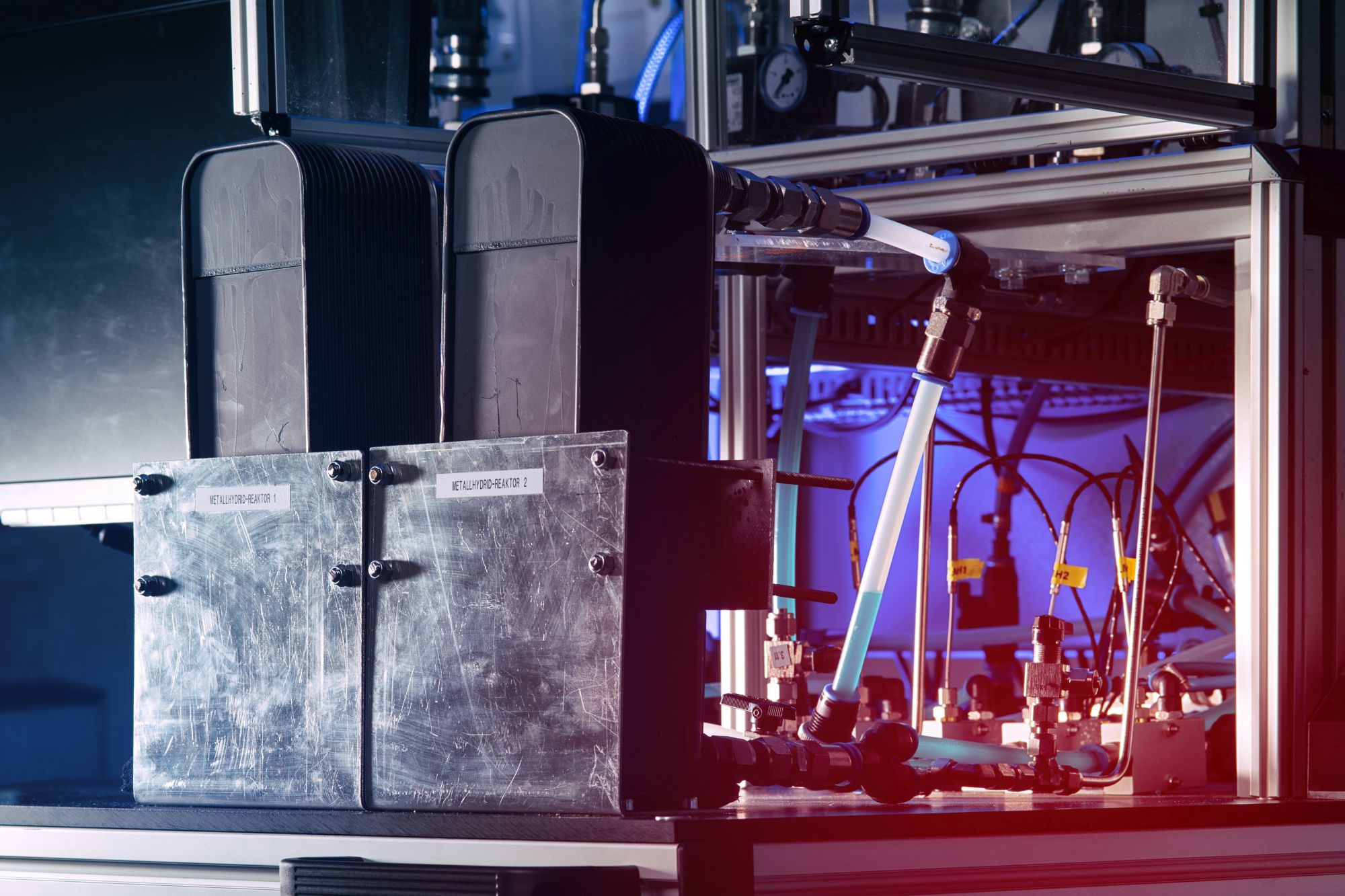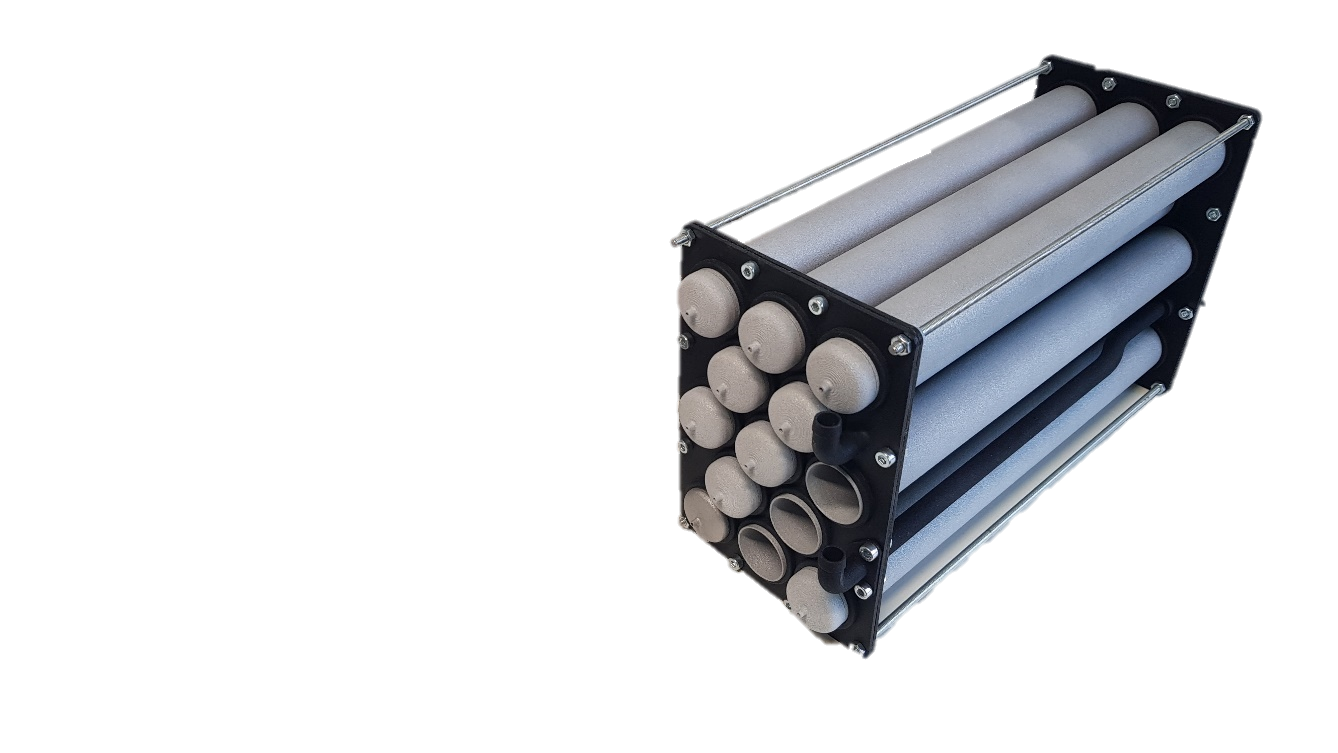Using hydrogen as a refrigerant to utilise the pressure difference between the high-pressure tank and the fuel cell system for cooling.
Hydrogen has to be compressed to store it on board a vehicle has to be compressed to high pressures to ensure a competitive volumetric energy density. The energy used for this has remained largely unused so far, as there is still no technical solution for this. By integrating a new type of metal hydride refrigeration system, this potential can be exploited and, depending on the application, up to 10% more range can be achieved.
The cooling power of the metal hydride refrigeration system is based on the temperature- and pressure-dependent equilibrium reaction between hydrogen and a metal hydride, which provides quasi-continuous cooling power generation in two half cycles.
Test bench - Facts:
| Material: | C2 hydralloy (TiMn2 based alloy) |
| Total mass of reactors (without valves): | 12,2 kg |
| Total volume reactors: | 5,4 l |
| Absorption pressure: | 35 bar |
| Desorption pressure: | 4 bar |
| Cooling capacity: | 662 W at 20°C cooling temperature and 30°C ambient temperature |
Operating principle
In the first half cycle, the hydrogen is fed from the pressure tank onto the metal hydride and the heat generated by the reaction is released into the environment. In the second half cycle, the hydrogen is then released from the reactors to the fuel cell at a low-pressure level. Herewith, heat can be extracted from the vehicle interior for instance and the desired cooling power is utilized then.
Advantages
- Hydrogen as a working fluid (low Global Warming Potential - GWP)
- No hydrogen consumption
- Absorption and desorption produces heat and cold
- Quasi-continuous through 2 reactors
In winter, the system can switch accordingly and there is an additional heating benefit.
It is important that the hydrogen for cooling power generation is not "consumed", but is completely returned to the fuel cell.
Metal hydride reactions can be used at temperatures below 0 °C compared to other gas-solid reactions because there is no phase change - no ice formation. In addition, due to the small molecules and the high reactivity of hydrogen, the reaction speed is very high even at low temperatures. Thus, many metal hydrides react completely within a few seconds even below 0 °C. With these materials, it is therefore possible to achieve high weight-specific performance.
The reactor as a core component
The challenge of developing a suitable reactor is based on the transfer of the high material reaction rate and the associated thermal energy to a fluid. Since the equilibrium reaction can inhibit itself through temperature increase/decrease, the resulting cold and heat flows must be transferred as efficiently as possible to the desired heat transfer medium. Initial measurements with a reactor prototype in the laboratory test stand have shown that complete reaction times in < 100 s are also possible in the reactor. In the example, peak outputs of 2.5 kWth / kgMH and an average output of 1 kWth / kgMH were demonstrated. The next reactor generations will also be able to achieve a significantly higher temperature lift, which will improve the effective cooling benefit in the vehicle.
Integration in vehicles - Intelligent control and efficient integration
For the evaluation of the metal hydride technology at vehicle level, complete vehicle simulations were carried out in Dymola/ Modelica. The first results show, that the integration of an 8 kW fuel cell system and 1 kg hydrogen can increase the range by 6 % with the battery electric vehicle Smart Fortwo ED as an example. By coupling the test bench with simulation models of heavy-duty and rail applications, integration options can be quickly evaluated and the best solution can be selected based on the annual energy consumption . This allows applications from 10 - 400 kW fuel cell power to be evaluated.
The coupling of test bench and simulation also offers the possibility to further optimize the valve switching when switching between absorption and desorption. Depending on the cooling demand, fuel cell output and ambient conditions, the optimal operating conditions of the system can thus be investigated. Therefore, the energy reduction potential can be further increased.


